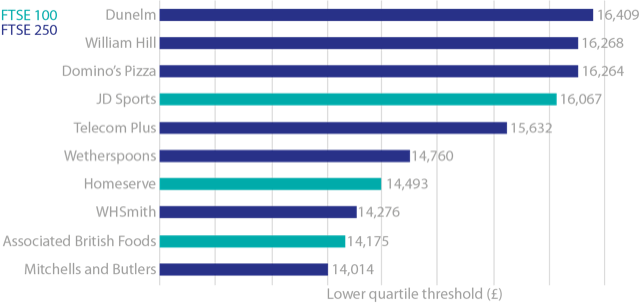Our analysis of the first ‘pay ratio’ reports finds some limitations to the disclosures, but also provides insights into low pay and inequality across corporate Britain.

The research, funded by Standard Life Foundation, is based on new pay ratio disclosures, published in 2019/20 for the first time, following rules requiring listed companies with over 250 UK employees to disclose their CEO’s pay relative to the upper quartile, median, and lower quartile pay of their UK workforce.
Analysis of the disclosures found that low levels of pay are widespread across the FTSE 350:
● 36 companies – 18% of the sample – pay at least a quarter of their employees less than £20,000 a year (on an fte basis).
● Of these, 34 companies pay all lower quartile employees below the annualised equivalent of the London Living Wage (£19,565), while 11 pay below the annualised equivalent of the Real Living Wage (£16,926).
FTSE 350 companies with the lowest pay levels at the 25th percentile point of their UK workforce (on an FTE basis)

The median CEO/median employee pay ratio across the FTSE 350 was 53: 1 and the median CEO/lower quartile employee ratio was 71: 1. These ratios are significantly higher for the FTSE 100, where the median CEO/median ratio was 73: 1 and the median CEO/lower quartile ratio was 109: 1.
The highest pay ratios were at Ocado, with a large incentive scheme payout to their CEO in 2019/20 resulting in a 2,605: 1 ratio between the CEO and the median employee, and a 2,820: 1 gap between the CEO and the lower quartile. The next highest CEO to median employee ratio was 310: 1 at JD Sports, while the second highest CEO to lower quartile gap was the 543: 1 recorded by BP. The lowest ratios were at asset management firm Sanne Group, where the CEO/median CEO/lower quartile ratios were 8: 1 and 13: 1 respectively.
10 highest CEO/median employee ratios

10 highest CEO/lower quartile employee ratios

Across different industries, the highest average CEO/median employee ratio was in retail, with 140: 1 while the lowest was 35:1 in financial services.
Even within industries, there were sizeable differences between companies. In the retail sector, lower quartile pay at companies whose pay-setting process involves union consultation and/or full collective bargaining agreements, did not fall below £18,000, and the average lower quartile threshold was £18,856.
At companies without full collective bargaining coverage, some lower quartile thresholds were below £15,000 and the average was £17,661.
The report notes that the pay ratio disclosures probably understate the extent of low paid work at major UK companies, as indirectly employed workers often in low-paid roles including catering, security or facilities management are not included in the calculations.
We have made a number of recommendations including:
● Expanding the application of pay ratio reporting requirements to cover large employers beyond listed companies, and expanding the reporting requirements to cover indirectly employed workers.
● Requiring more detailed reporting on high earners between the top quarter and the CEO, potentially enabling better understanding of the potential to redistribute pay from a small number of very highly paid employees to low- and middle- income earners.
● Requiring companies to disseminate their pay ratios directly to employees in an annual update, to give workers a better understanding of where they are situated in the company pay structure and enable them to make an informed judgement on the fairness of their pay.